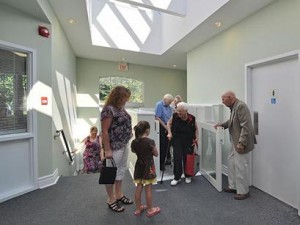History
The Anglican church of St. John the Baptist (Dixie) has become a modern, accessible building after extensive structural and cosmetic changes were made to the building in 2002, but its roots go all the way back to 1813 soon after Lord Simcoe decided to open a military road between York and Hamilton.
The first church on the site consisted of a log cabin built by the Union Church that dates back to the early eighteen hundreds. This small chapel was built to meet the needs of the Protestant Christian settlers that were filling in along the new Dundas Road. As the community grew, this log building was later replaced with a stone Chapel in 1837. This well built chapel still stands on the property today and has been designated a historical site as it is the oldest Union Chapel in Ontario. The Presbyterians of the area continued to celebrate in this chapel until 1910 when they built their own church to the north.
There is a large cemetery associated with the Dixie Union Chapel. In fact, it is one of the oldest in the county, with tombstones dating back to the earliest of settlers. In 1870, the Anglicans built a brick church to the east of this chapel and named it St. John the Baptist (Dixie). That church was struck by lightning in 1924 and the church was destroyed by fire. St. John’s community banded together and a new church designed in the same neo-gothic style was opened in 1926. Over the years beautiful stained glass bible scenes were added to the tall windows. The church of St. John has continued to grow and meet the changing needs of the community.
The 2002 addition made the church wholly accessible to all with disabilities, and it provided improved washroom facilities as well as desperately needed offices and meeting rooms. It has been said that this latest change to the building has been like a rebirth for St. John. The most recent phase of renewing our sacred space was a cosmetic update of the Parish Hall, leaving us with facilities that are modern, accessible, and which complement our beautiful historic church.
All these changes have witnessed to the community that St. John’s is a sacred space with deep roots in the past, firm grounding in the present and renewed for the future.



